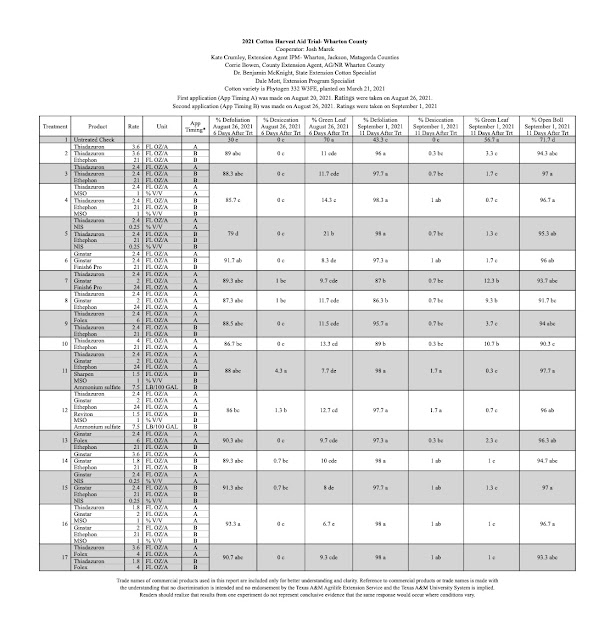Howdy yall,
 |
Open Cotton in Jackson County
Kate Crumley |
We are still seeing a few red banded stink bug around in our soybeans. The economic threshold for redbanded stink bugs in soybeans is 16 stink bugs per 100 sweeps, which is lower than the 36 per 100 sweeps for other stink bug species. Acephate tends to work better on redbanded and brown stink bugs than pyrethroids do. We also need to consider the pre-harvest interval for any fields that may be treated for those. For more information on stink bugs in soybeans check out the Soybean Insect Guide.
 |
Redbanded Stink Bug in Soybeans
Kate Crumley |
Grain harvest is running and a lot of our cotton is being defoliated. There is still a bit of cotton with some growth on the top, but for the most part we are done. Cotton is no longer susceptible to economic damage by plant bugs and bollworms at 350 degree days (DD60), or heat units, past cutout, and is no longer susceptible to economic damage from stink bugs at 450 DD60 past cutout.
 |
Open Cotton in Jackson County
Kate Crumley |



Recently I’ve seen more kissing bugs moving around than in previous years, and had one dropped by the office. If you do find a kissing bug, please do not touch it with your bare hands. Kissing bugs are a nocturnal blood feeding bug. They take several minutes to feed, and the bites do not usually hurt when they are feeding. They do not attach like a tick. There are eleven different species of kissing bug, and most of those are native to our area. About 50% of kissing bugs are estimated to be infected with the Chagas parasite,
Trypanosoma cruzi. More information on these can be found at the
Texas A&M website on kissing bugs and chagas disease.
If you find a kissing bug in your home, you can drop them by our office or email me a photo to confirm it is a kissing bug. If there is no concern of human exposure, but you would like your kissing bug tested for chagas, we can send your sample to A&M for testing. You can bring them to our office or follow the directions on the A&M kissing bug website. If the insect is found in your home and a person has been bitten, you can bring them by our office to mail, or follow the directions on the
Texas Health and Human Services website to send them a sample. The Texas Health and Human Services lab can only accepts kissing bugs involved in human exposure, not insects just found outdoors that haven’t bitten anyone. Again, please do not pick up kissing bugs bare handed.
 |
Kissing Bug found in Matagorda County
Kate Crumley |







